Alice Ramsey said that starting a car with a crank was a “clash with an unpredictable temperament; a gamble with a possible broken arm.” The words of the first woman to drive across the United States back in 1909 echoed in my head as I grab the metal handle jutting out of the grille on the 1906 Maxwell in front of me, a car similar to the one Ramsey drove. “You have to push the crank in while you turn it, then feel where it catches,” says Tim Simonsma, the Maxwell’s owner. “Now give it hell.” If I snap my radius in half, I think, this story had better be worth it.
It takes two people to start the Maxwell: one to crank and the other to move the spark advance into the correct position and depress the throttle. With Simonsma on the controls, I give it my version of hell. The car coughs, shudders like a mastiff shaking off water, and then its two cylinders rattle to life. Mercifully, my arm remains as God intended.

A 22-year-old Ramsey and her three female companions sardined into a similar motorcar outside the Maxwell dealership in New York City on June 9, 1909. This was a mere 44 years after Robert E. Lee surrendered at Appomattox, when out of a US population of 80 million, only 200,000 owned cars. Ramsey and her passengers – her two sisters-in-law, Margaret Atwood and Nettie Powell, both in their 30s, and Hermine Jahns, their adventurous 16-year-old neighbour – had 3000 miles of wild blue yonder between them and San Francisco, with nothing more than dirt buggy paths and macadam, a crude form of crushed-stone pavement, to convey them.
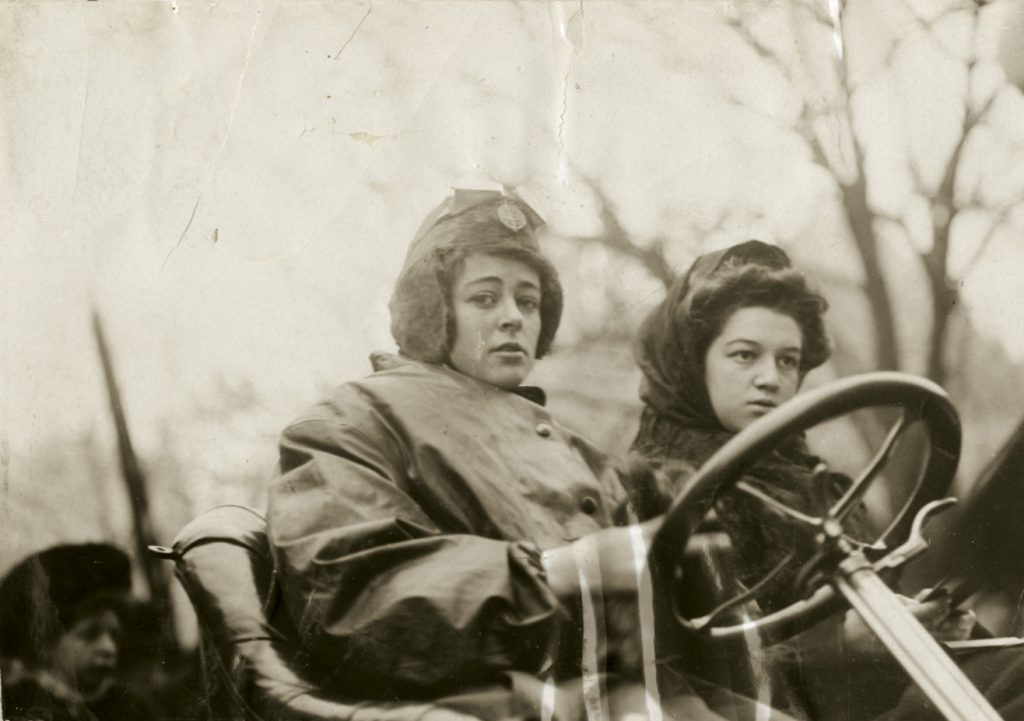
When Ramsey started her transcontinental attempt, women were still 11 years away from being able to vote. That nod of equality took decades of protest and agitation. Ramsey’s part, though she always claimed to not be a suffragette, was proving a woman was equally capable as a man to drive a car. “Good driving has nothing to do with sex,” she said. “It’s all above the collar.”
Simonsma, a Sacramento native and Maxwell collector, trusted me with a car in which to tromp about his rural neighbourhood in Wilton, California, just outside the state capital. His two-cylinder, three-speed 1906 Maxwell Model H looks virtually identical and, minus two cylinders, drives similarly to the one Ramsey wrangled on her extraordinary exploit over a century ago. I was climbing onto the shoulders of one tough-ass broad.
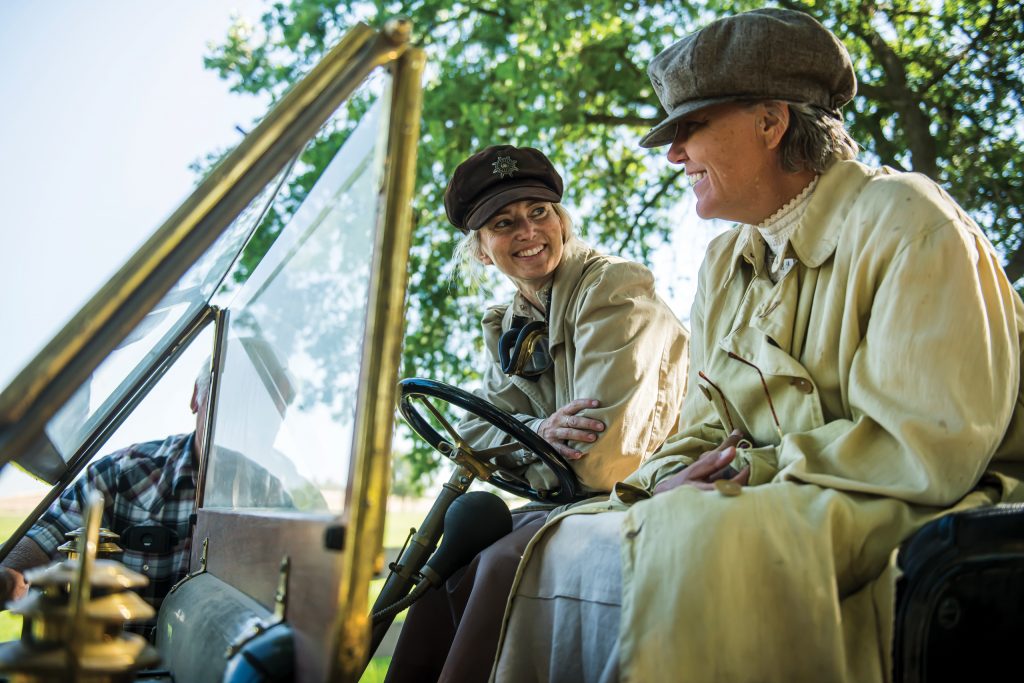
Ramsey, married to a New Jersey lawyer and with a two-year-old son, took to driving instantly. She ground out 6000 joyriding miles in her first car, a red two-cylinder Maxwell K runabout that her husband, John Rathbone “Bone” Ramsey, bought her. If Mr Ramsey had known what that sporty $1750 purchase would beget, one wonders if he would have made it. With miles of dirt already covering her driving duster, Ramsey upped her ante. She entered rallies and mechanical-reliability trials that saw her cover punishing 150-mile stretches over sandy dunes, rutted dirt paths, and muddy roads that pushed both car and driver beyond their implied abilities.
Enter one Cadwallader “Carl” Kelsey, the Maxwell Motor Company’s P.T. Barnum of automotive marketing. His promotional shenanigans were the stuff of legend, with stunts including driving company cars up the steps of churches and city halls and engaging the police in chases to exhibit a sporty model’s speed. One time he had a Maxwell run for 10,000 miles without turning off the engine to extol its durability.
Imagine the scene: Kelsey – a practiced snake-oil salesman in a three-piece – approaches a lady and her female companion after a driving event in Montauk, New York, in 1909. He compliments her bronze medal from the day, then slithers into the banquette beside her to pitch a superlative, never-before-accomplished feat by a woman: a transcontinental trip. Ramsey, who was at the time president of the Women’s Motoring Club of New York, admitted the notion initially flabbergasted her. It took six days for her to agree to what Kelsey himself called “the greatest promotional stunt of my career.”
The first successful cross-country drive, accomplished by Horatio Nelson Jackson in 1903 with a 20-hp Winton, began as a wager. Jaunty gents in Packards and Oldsmobiles made subsequent efforts. Of those trips, only one woman, Minerva Teape and her daughter, made an attempt, in 1908, in a Waltham. Illness foiled their plans.
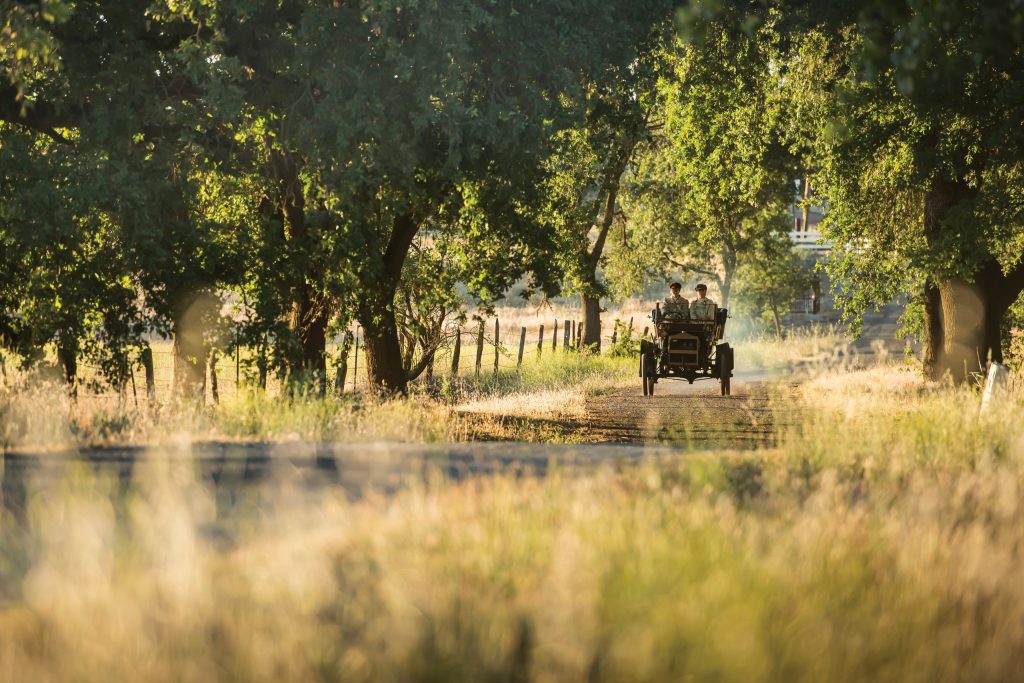
As I squeeze past the long emergency brake and shifting levers into the right-hand driver’s seat, the itchy, long skirt and floor-length canvas duster coat I wore to suitably re-create the era twist around my body as if a vine climbing a tree. Oh well, write enough stories for Hagerty and you eventually end up in a costume.
“It sounds like a two-stroke motorcycle but with a lower pitch,” my left-seat passenger and fellow automotive journalist Emme Hall says. Under its cowl, the Maxwell’s simple boxer-type engine, each piston punching away from the other, clacks rhythmically in front of us. Maxwell’s ads, the slogan for which was “Perfectly Simple; Simply Perfect,” claimed this two-cylinder mill made an ideal choice for the casual motorist.
Without markers on the shifter, finding the gears on the Maxwell’s transmission proves challenging. “It’s got a ‘wonder transmission,’” Simonsma explains. “You wonder where the gears are.” Reverse lives far forward, neutral next, then first, second, and third reside in sequence the further back one pulls the lever.
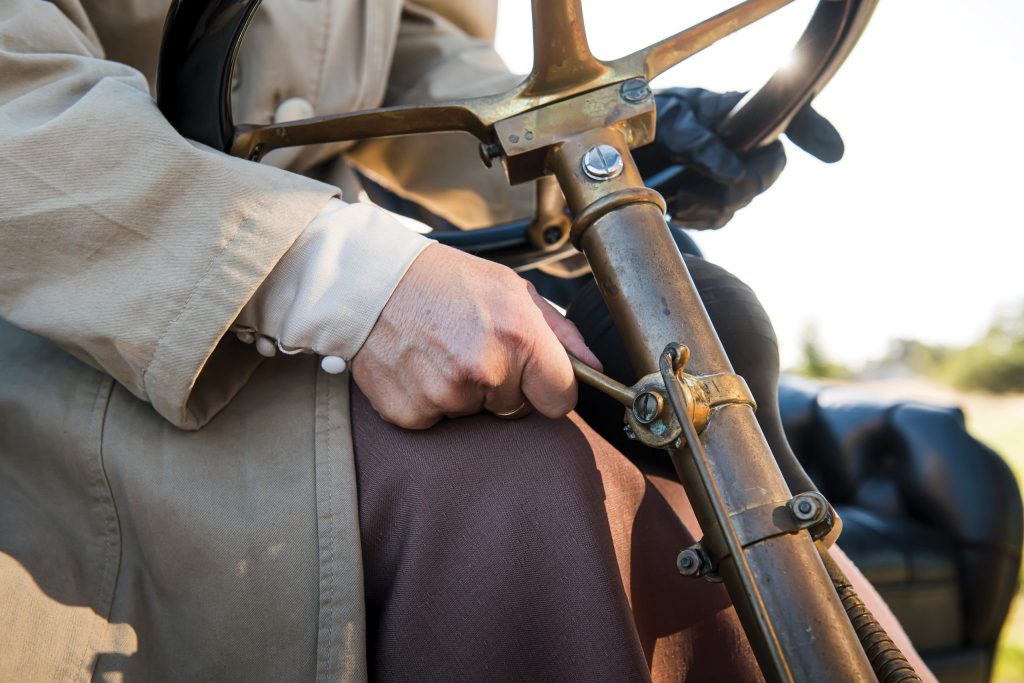
Pedal positioning on the Maxwell feels more similar to modern cars than I anticipated. The throttle on the far right doesn’t want a soft touch. To the left of the steering column you find the brake pedal. The clutch sits at the far left of the driver. Every time I try easing the Maxwell into first gear, we jerk forward. I never quite master its engagement point. Steering the Maxwell feels at the same time heavy and hair-trigger sensitive. When I blink, we veer off course, the car having been built before the auto industry discovered the wonders of caster and camber. A rock in our path the size of a nickel would move the Maxwell willy-nilly over the road. The Maxwell’s leaf springs bounce the car along on tyres that look marginally wider than those of a modern mountain bike. Dirt swirls around Emme and me, and I’m fairly certain I swallow more than one flying insect during our drive. I’ve done plenty of off-roading in my time, but this is the kind you feel in your DNA. Then I imagine driving like this for months on end.
Some newspapers declared Ramsey’s attempt to drive across the country ridiculous and beyond the capabilities of a woman. Others, including the Los Angeles Times, trumpeted the attempt. “Mrs. Ramsey is one of the most daring chauffeuses (sic) in America … she will do all her own adjusting and make all necessary repairs when the car is too far from a garage.”
Women, while hardly encouraged, were nonetheless no strangers to the automobile. Bertha Benz notably traveled an astounding 65 miles in 1888, the farthest anyone had gone in a motorised carriage before. In 1900, Anne Rainsford French Bush was the first woman in America to earn her driver’s license. Frenchwoman Camille du Gast became a motorsport star during the 1901 Paris-Berlin race after beating out 89 of 122 competitors. Englishwoman Dorothy Levitt won her class at the Brighton Speed Trials in 1905, taking her 80hp Napier to 80mph. If Ramsey could pull off this feat of cross-country driving, she would find herself in sanctified company.
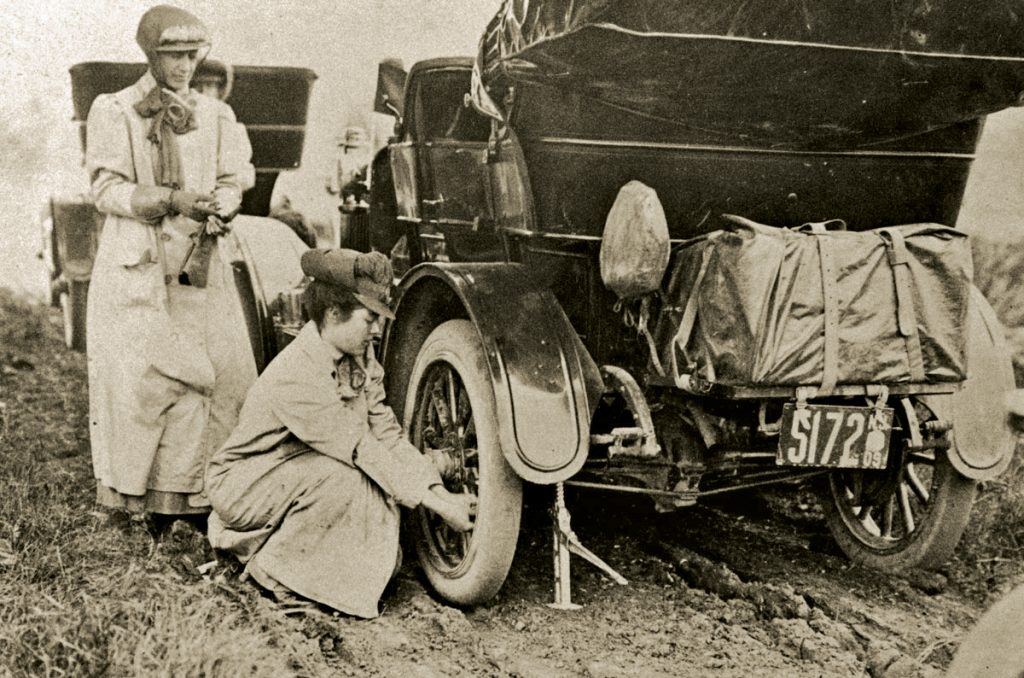
John D. “JD” Murphy, automobile editor for the Boston Herald, served as Ramsey’s publicity man, feeding information about the trip to local newspapermen in advance of the ladies’ arrival into each city. Murphy also ensured that Maxwell dealers along the way would “keep on hand tyres, gasoline and spare parts in case of any breakdowns, and asked that their representatives give us every possible attention,” Ramsey wrote in her book recording the journey, Veil, Duster and Tire Iron.
Within a day of starting the odyssey, the party was slipping over muddy roads, requiring Ramsey to attach tyre chains to keep going. Their first destination was Poughkeepsie, where Ramsey had attended Vassar. Only three waterlogged days in, a mechanic in Auburn needed to replace the Maxwell’s starting coil. A 138-mile drive later that night using their kerosene-burning cowl head- and taillights was the first time the party saw dry roads. They hadn’t yet made it out of New York.
The Maxwell’s four cylinders were individually cast and water-jacketed. A lost-oil system lubricated the engine, meaning oil flowed through, then out – no filter or changing required. If anyone had wanted, they could have followed the inky slick the Maxwell deposited from sea to shining sea. Two sets of brakes, an external contracting set and an internal expanding one, managed the Maxwell’s 40mph top speed. Barely.
Ramsey’s Maxwell came fitted as standard with a skid plate. Other than emergency supplies – including a shovel, spare oil, a 5-gallon (19 litre) petrol can, axes, tyre chains, a toolbox, and a 20-gallon (76 litre) tank to replace the factory 14-gallon (53 litre) tank – the car was showroom standard and cost around $1800. They picked up other recovery gear along the way, according to Ramsey, including “a stout towing rope, a block and tackle and … a tank of compressed air to supply the tyres in case of an emergency.” Long canvas strips were used for driving along sandy roads to help give the treadless tyres better bite. Even in chains, they often lacked grip.
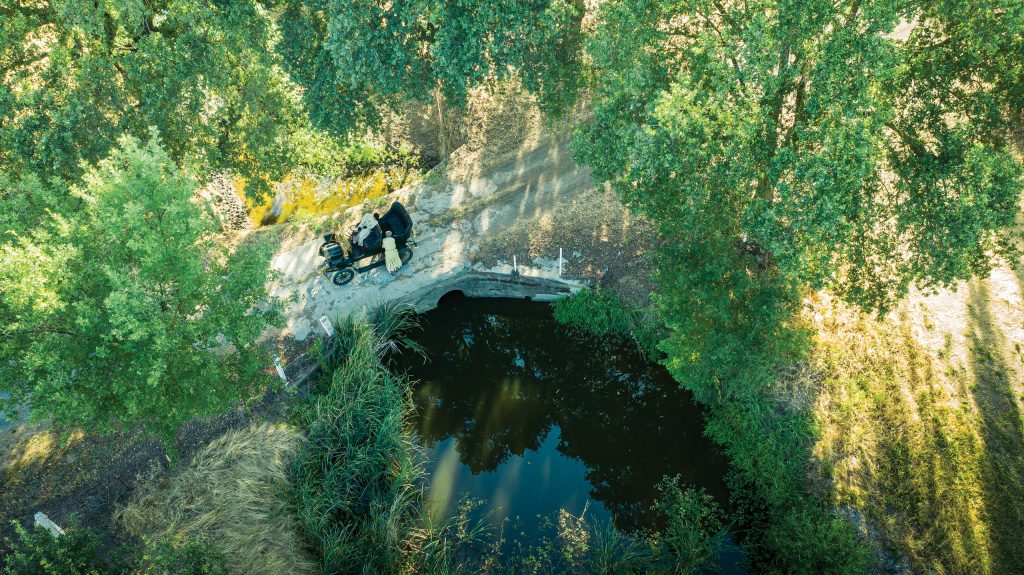
“Her preparation is so close to what we’d do today,” says Renée Crist, curator of collections at LeMay – America’s Car Museum in Tacoma, Washington, where the rebuilt 1909 Maxwell DA that re-created Ramsey’s journey in 2009 currently sits on display. Those women “rose to the challenge and embraced its rigours. I’d love to ask them: Was (the decision to take this trip) complete ignorance, or did they understand the magnitude of what they were doing and the legacy they’d leave?”
Cargo restrictions limited the women to a few personal items each, including a stylish suit, a pretty blouse, and an extra pair of dapper shoes for the city. They also carried the usual change of unmentionables plus overnight gear. Their oversize dresses of the era took up most of the room on the car’s moderately cushioned seats. To best camouflage the dust, the ladies agreed on outfits of tan cloth under their long dusters and rubber ponchos for when Mother Nature periodically wept on their open-topped car. Happy tears, no doubt. With all its extra gear and passengers, the normally 950kg Maxwell weighed more than 1700kgs.
In spite of the agreed wardrobe restrictions, somehow her three companions, upon arriving in Buffalo, New York, “produced beflowered and beribboned hats of ample dimension. Where they hid them, I’ll never know,” said Ramsey, who had to remain content doffing her motoring cap with its billowing muffin top at publicity events.
To find their way during the first half of their journey, Ramsey’s cadre of navigatrixes used the Automobile Blue Book. This was a road guide in the pre-map era used by travellers throughout North America. Instructions that included buildings, geographic landmarks, mileage points, and directional headings guided tourists before numbered routes existed. But even the Blue Book wasn’t a reliable resource. At one point, Ramsey drove over a mile out of her way looking for a turn at a yellow farmhouse. When she finally stopped a woman to ask for help, the bystander explained that the farm’s owner hated the newfangled automobile, so he repainted his yellow house to green to mess with motorists along their way. Where the road book inevitably failed, necessity inspired invention, and Ramsey followed the telephone poles with the most wires, assuming those would lead to the biggest towns.
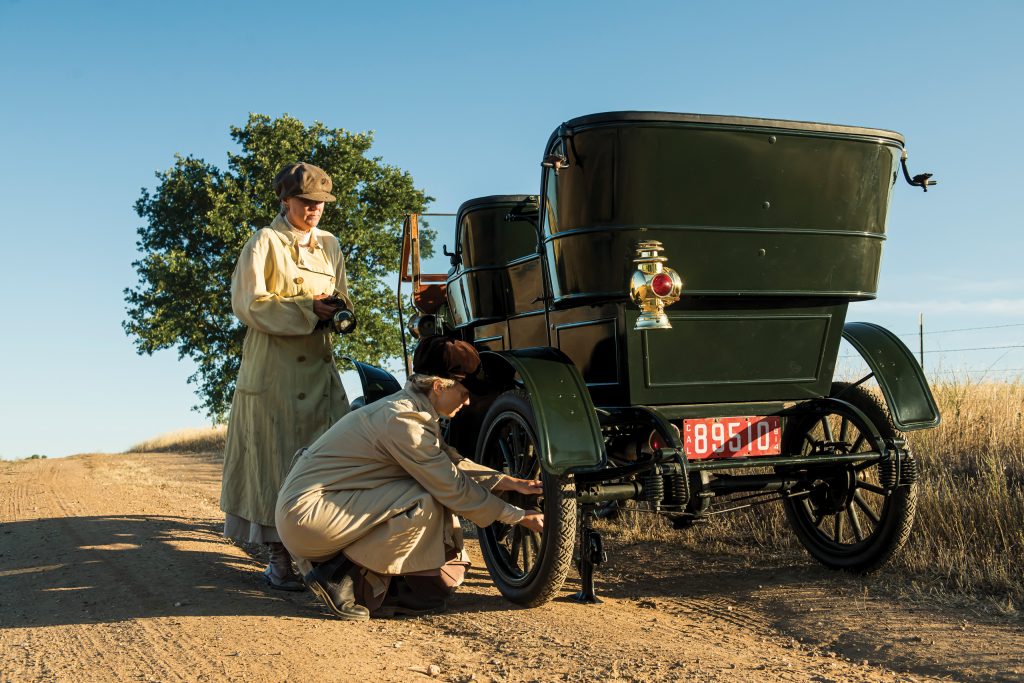
Upon the party’s arrival in each city, the PR man, Murphy, had prepped the local press well. Newspaper headlines read like Maxwell advertisements extolling the car’s durability and moxie, claiming it was making the trip “without a particle of car trouble.” Not exactly. The Maxwell met misfortune aplenty – which was often bested by female ingenuity. During one leaky radiator incident, Ramsey’s sisters-in-law filled their French-cut glass perfume bottles with rainwater from puddles to cool the engine. To change a flat, as she often did, Ramsey would reach into the tyre casing to pull out the inner tube “as Mother used to extract the entrails of a turkey.” She would then rough up the rubber inner tube and apply cement to seal the hole.
Outside Jefferson, Iowa, loomed Danger Hill, an ominous incline that stood between them and Nebraska. Early motorcars attempting the intimidating grade often went up in reverse because that gear afforded them the greatest torque. With a 90-degree turn at the hill’s base, there was no using momentum to charge up the steep slope. Encouraged to avoid the hill and put the car on a train, Ramsey baulked. Instead, her three companions unloaded their luggage and got on the train, meeting her in Nebraska. Murphy rode shotgun with Ramsey to document the progress of the lightened car.
Two-thirds of the way up Danger Hill, which was graded in 1920 to be less severe, Ramsey and Murphy happened upon a lame-duck motorist. Digging out the tyres did nothing for the driver’s Mitchell touring car, which simply lacked the power to make the summit. Ramsey strapped the hamstrung car to hers, then instructed the Mitchell’s occupants to start their motor and put the car in low gear so she wasn’t pulling dead weight. Both Maxwell and Mitchell made it without further incident. If only Murphy had Instagram at his disposal back in the day.
It took 13 arduous days and one spark plug cleaning and reassembly to get through Iowa and its mud, which was so thick that locals called it gumbo. At times throughout a journey that meandered up and down the Plains states to avoid weather and other hazards, Ramsey and the ladies used fence posts under the wheels for traction, then rebuilt the fences before getting on their way. “In negotiating those furrowed stretches, it was fortunate that the differentials were built nine- or ten-inches above the ground or we would have bogged down long since,” Ramsey remembered.
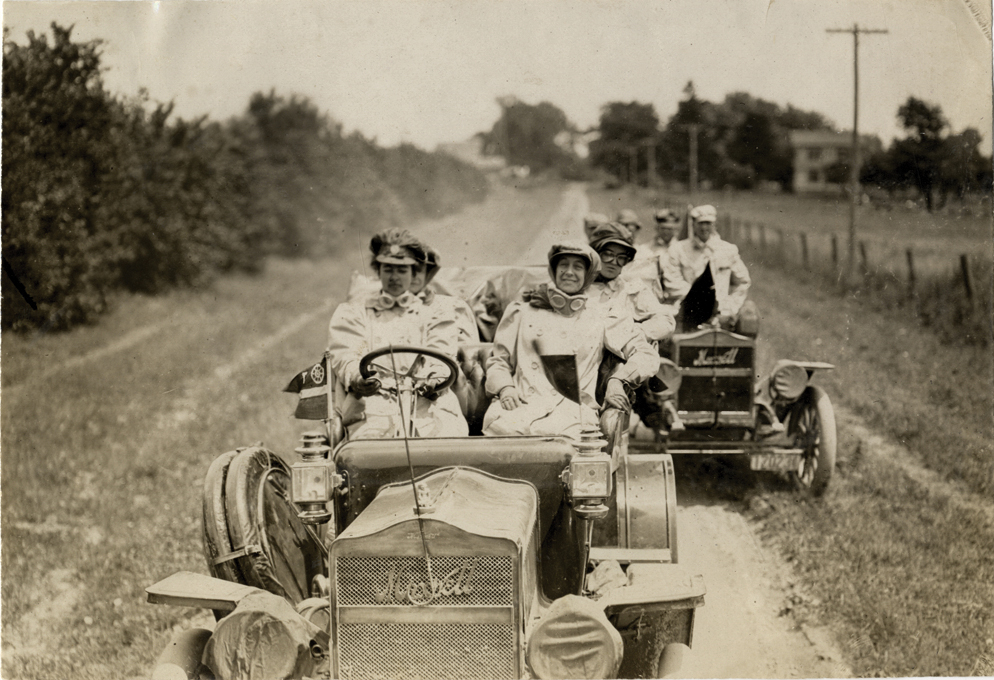
A busted rear differential and a catastrophic mudslide threatened to further waylay the trip, but Ramsey learned about an alternate route avoiding forecasted treacherous conditions, helping her ultimately beat the previous 62-day cross-country record set by a man. They sallied forth through Sioux City, crossed the Missouri River, and reconnected with their planned route in Jackson, Nebraska. There they met with smoother roads and thus a happier car and crew. “The second and low gears had taken over for so long a time that we almost forgot the Maxwell had a third or high gear,” Ramsey recalled.
Another diversion sent the car northward into Wyoming, where the Rocky Mountains excited Ramsey about as much as a visit to the dentist. “The country is practically free from trees and the mountains are bare and unbeautiful.” Good thing she wasn’t working for Wyoming’s tourism board. Over each intimidating peak, her passengers followed the car with the recovery gear they’d had the prescience to pack. In low gear, Ramsey inched forward while the ladies prevented the wheels from slipping using rocks or wooden blocks. Rinse and repeat. Down hills and through ditches, Ramsey employed both foot and hand brakes as she negotiated the weight of the Maxwell, holding it back from careening radiator first into anything but air.
More than a century later, I could feel the tufting of the leather bench seats through my layers of clothes after only an hour behind the wheel. We started our day before sunrise, but as the sun and temperature rise, my vintage garments trap the intensifying heat. The fresh air through the open car feels good as Emme and I drive the dusty trails of rolling ranchland, but considering how much work the Maxwell took to manoeuvre and a blistering sun overhead, accounting for weather would have become more about survival than comfort for Ramsey in the early days of motoring.
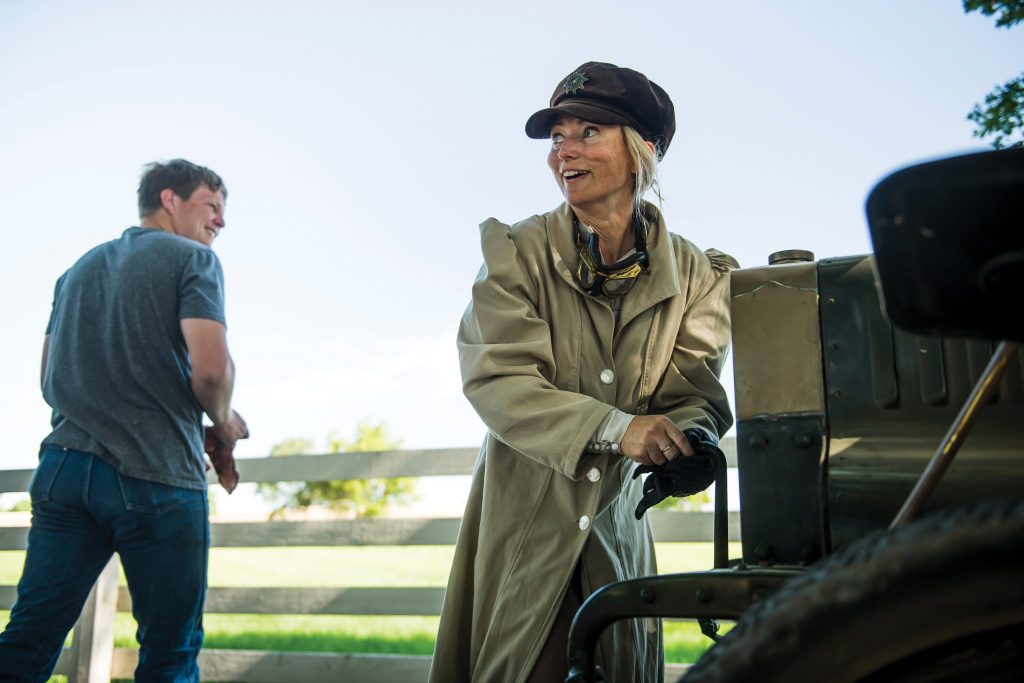
Weather aside, one of Ramsey’s more vexing encounters came not because of the Native Americans they met, who, with bows and arrows drawn, chased a jackrabbit around the car. Nor was it the murderer who was being tracked by a horse-backed posse. Rather, a wee prairie dog afforded Ramsey her biggest distress when the bolt connecting the right-front wheel to the tie rod came out after the wheel hit an enthusiastically dug hole. It pitched the car forward, landing the whole shebang in a ditch and breaking the spring seat off the front axle.
MacGyvered with some wire, the Maxwell limped to a ranch where a less-temporary fix was made. But that wouldn’t last through the remaining washouts and irrigation ditches, so the car was abandoned in a ravine to await a new front axle from San Francisco that never came. Instead, a gifted blacksmith in Callao, Utah, on the old Pony Express trail just short of the Nevada border, welded the old one, finally getting Ramsey back on the road.
The trip over the Sierra Nevada provided another postcard landscape. Ramsey counted the snow-covered peaks and the accompanying valleys stretched out beneath them as some of the most spectacular country she’d ever seen. Lake Tahoe stunned the driving party with its inimitable beauty. Their golden fleece was almost within their grasp after 56 punishing days on the road.
Two hours into my Maxwell drive, I was ground round and apologising profusely to Emme every time we caught air off the seats after driving over ruts or bumps. It made me think about how women tend to apologise for everything, including things outside their control. I wondered how many times Ramsey said, “I’m sorry.” Or did that not-so-delicate driving party unspoiled by air suspensions and zero-gravity seat technology simply carry on?
The group’s exhaustion notwithstanding, excitement built as the women closed in on Sacramento, then on to San Francisco. The closer they got to their final destination, the more automobiles joined “the sister motor maids,” as reporters dubbed them. After they drove down Market Street to the Maxwell showroom, the San Francisco Chronicle reported that “[Ramsey] was accorded a reception such as few women receive.” She’d made history. Huzzah, ladies!
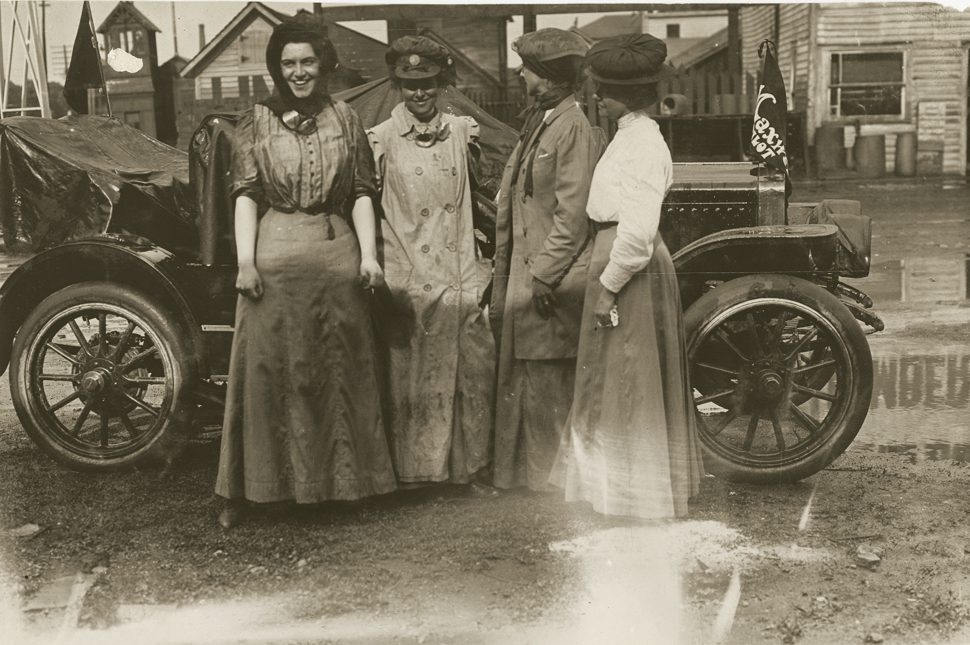
For Kelsey and for Maxwell, this plucky woman had made headlines across America. However, she didn’t do it for the publicity, but to prove a point. “Women can handle an automobile just as well as men,” she said.
By 1926, Chrysler had absorbed the Maxwell brand. Maxwell’s four-cylinder car joined the lineup for a while, badged with Chrysler’s winged seal. Ramsey’s legacy lasted longer. In 1960, the American Automobile Association named her “Woman Motorist of the Century,” and the Automobile Manufacturers Association regaled her as the “First Lady of Automotive Travel.”
“I was completely surprised and deeply moved to receive these tokens of recognition,” Ramsey said of her accolades. “I am still driving across our land annually,” she said in her 70s, when modern road improvements meant the trip now only took a week, more or less. The joy of driving stayed with her throughout her life, which closed at the plum age of 96 in a Los Angeles suburb.
As my day with the Maxwell ends, I unbutton my high-collared puffy shirt, relieved I had not done any damage to the car or myself. Dirt circles my raccoon eyes where my goggles had been. I think back to our pre-sunrise safety briefing and what Simonsma said to our group before I started driving: “We’re here because of Alice. Let’s do right by her today.” Hopefully I honoured his request. For Ramsey, surely any rigours of the historic 59-day journey upon which she embarked were worth it. For my being able to step back somewhere in time and share her story, I’d have risked far more than a broken arm.
This story was originally published in the Hagerty Drivers Club magazine in America.









The ‘Wait and See’ journey across Africa from West to East performed by 2 Jowetts in 1926. Known by very few people outside the Jowett car clubs.
Lovely story of true adventure, so much harder to find now.
Wonderful achievement and a great story ! Thank you.
This was a great story of someone and something I was not aware of.